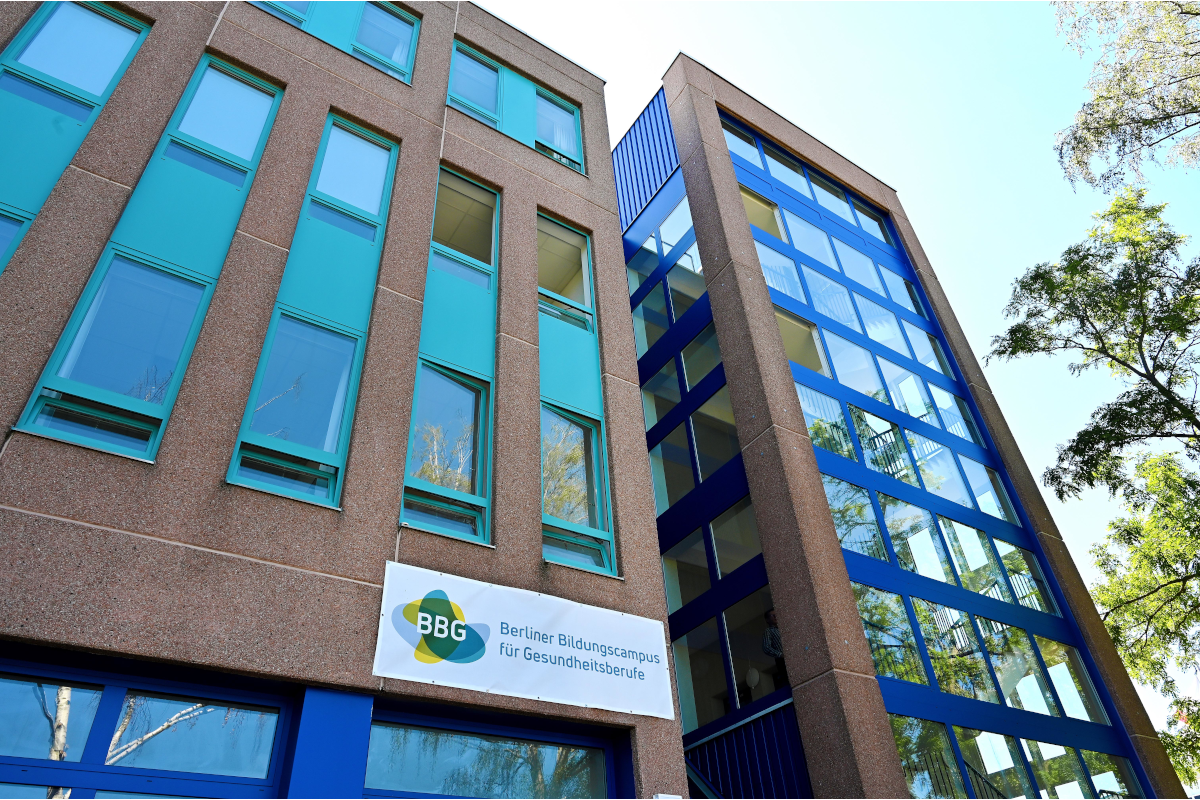Berlin Education Campus for the Healthcare Professionsby Charité and Vivantes
The nursing care and healthcare professions are particularly plagued by a shortage of skilled workers. In an attempt to fend off this trend, Charité -Universitätsmedizin Berlin and Vivantes Netzwerk für Gesundheit GmbH have joined forces in Berlin and founded an education campus for healthcare professions. The joint venture intends to offer training and further educational courses for the healthcare professions for up to 3,500 students on a single campus in the future. There are currently three educational centres in Berlin-Neukölln, Centre and Reinickendorf.
The new campus “Berliner Bildungscampus für Gesundheitsberufe” (BBG) was opened in early 2020 as the largesteducation campus in Germany for the nursing care professions. True to the motto “nah an der Praxis, nah am Menschen”, which roughly equates to on-the-job training being as close as possible to those who need nursing care, 2,100 students are already learning the ropes of the nursing and healthcare professions at three different sites in Berlin. Over the coming years, the two main responsible bodies –Vivantes and Charité –will gradually increase the number of places available to 3,500. Besides providing courses for nine different professions in the healthcare industry, the BBG also offers further education and qualifications. As teaching and research have become increasingly intertwined in recent years, the campus also offers sandwich courses in partnershipwith three universities. “This allows us to create new dimensions of interaction, link up different departments and players in the healthcare sector and lay the foundation for a holistic approach to nursing care,” said Judith Sefzik, Marketing Officer at BBG.
New premises had to be found for this pioneering approach. A former office block was leased and refurbished in Reinickendorf. “The challenge was that the existing room layout was not suitable for teaching purposes,” stated Ralf Ruske, owner of the architecture firm “r2_innenarchitektur und design” which was responsible for the conversion. “Consequently, we took down all the walls except for the load-bearing ones and reconfigured the different floors”. The conversion was completed in record time. Afteronly four months, the first phase of construction was handed over in September 2019, followed by the second phase in March 2020 after just under another six months. The students of Nursing Care 1, Nursing Care 2 and Nursing Care Assistance are now studying in the new, light-flooded, modern equipped rooms of the northern part of the campus (Nord). There is a smartboard in all of the classrooms which enables interactive teaching to take place, the results of which can be made available to all the students. They are supported and supervised by teachers and administrative staff, who take care of all matters in bright, friendly rooms, from registration to the preparation of teaching concepts, to the graduation ceremony.
Large windows as well as sandy beige floors, and furniture in both white and light wood convey a spacious atmosphere and feeling of ease in all rooms. To find one’s way more easily around the building complex, a colour concept was developed for the classrooms and administrative areas. This is reflected on the walls and curtains, of which the latter came from the Emsdetten-based textile manufacturer drapilux. “We were looking for fabrics that were practical and hard-wearing. The drapilux fabrics fit perfectly into the overall interior design concept and meet the technical requirements. They are flame-retardant, easy to care for and crease-resistant,” explained Torsten Jacques, interior decorator and managing director of zoom GmbH.
A total of 1.4 kilometres of the semi-plain Article 109 was used. A calming blue was chosen for the classrooms to match the accent colour of the front wall. Light, on-trend grey curtains were chosen for the administrative offices and lecture theatres. The semi-transparent material provides protection against the light on sunny days whilst allowing the rooms to stay bright. The fabrics have been provided with the intelligent added function drapilux air in order to keep the air fresh. Metal salts incorporated into the fabrics break down odour molecules and transform them intoharmless carbon dioxide and water. This breaks down bad odours permanently. “We are extremely happy in our new premises”, stated Judith Sefzik. “The bright, friendly atmosphere creates a wonderful learning environment.”

